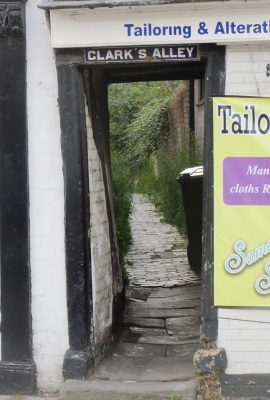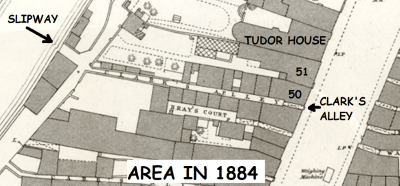Clark’s Alley
to Expand
Clark’s Alley links Red Lane, alongside the Mill Avon, to the High Street. It is unique amongst accessible alleys in having lines of raised brick in the paving up the slope from the river, to give purchase to those manoeuvring heavy loads. There is a similar feature in the adjacent Care’s Alley, but this is now closed to the public.
The alley must have been one of the last to be paved, in 1901, together with Care’s Alley. The pump was probably removed at the same time and the well filled in. A short while ago, we were reminded of the well location when a sink hole appeared.
The alley name has changed several times through the years. In 1820 it was Clerk’s Alley, which may be a misspelling of the present name. In 1842, Dobbins’ Alley (William Dobbins owned 50 High Street, the front house) and in 1870 there is reference to Wilkinson’s Alley.
Katherine Clarke, for whom the Alley was possibly named, was a schoolmistress running a dame school from the front house. In 1841, there were two teachers with her and eight resident pupils. The ‘Tewkesbury Register and Magazine’ of 1849, though, suggests that John Wilkinson, the Parish Clerk, lived in the alley and it became known as the Clerk’s Alley. It said that in the great flood of 1770 he drove a large nail into the wall to mark the height of the water, which was there for many years.
The alley was never heavily populated. By the nineteenth century there were no more than four houses. The lower end of the burgage plot had at some time in the past been incorporated into the garden of the next house, 51 High Street (Now the bar of the Tudor House). Opposite the bottom of the alley was a slip, which was filled in in 1923, having become a dumping ground for refuse. This was principally used for delivering coal. A coal yard in the alley had previously been a slaughter house, closed in about 1890.
The occupants of the alley were generally solid, law-abiding citizens following a wide range of occupations. Possibly the most notable was Mrs Fletcher, nee Tovey. Born in 1822, she became a Tewkesbury centenarian. Her husband, a gun-smith, died from the effects of a fire he was fighting whilst a young man and left her with six children to bring up alone. She died in the workhouse infirmary in 1924.
To get a glimpse of the struggle that poor people must have had, Elizabeth Wright can be followed through the census for thirty years in the same tiny alley cottage. In 1841, aged 40, she was married to Joseph, a labourer and lived with two young daughters and a 25 year old relative, probably from an earlier marriage, a washerwoman. By 1851, she was a widow. In the house were her two daughters; Emma (16) a charwoman and Amelia (15) a silk throwster. There was also her son from her earlier marriage, a waterman, with his wife and four children, all described as paupers. There was also a ‘visitor’, a silk weaver. Eleven people in all! By 1861, the household was reduced to nine. Her daughter-in-law was also a widow, Emma had left, presumably married, and there were six grandchildren, with three surnames. All over eleven years old were in employment. By 1871, the family was gone. Only one house in the alley was occupied.
In 1936, the council issued a demolition order. The site was incorporated into the garden behind the house adjoining, now the bar of the Tudor House Hotel. Nowadays, the footprint of the cottages is occupied by the bar’s toilet block.
More recently, cottages in the adjoining Bray’s Court have been replaced with new cottages facing on to Clark’s Alley, so there are people living in the alley again, but in far better conditions that their predecessors.




Comments
Monday 30-Dec-2024 by: DavidRSmith
Hi,
I have read your article with interest, as the Elizabeth Wright mentioned is my 2x great grandmother, you state that the family had disappeared by 1871. This is incorrect the Amelia Turberville shown on later censuses was Elizabeth Wright's daughter Amelia mentioned in your article. The family was still there on the 1911 census and Amelia died in 1912 having spent her whole life living in the same cottage in Clarks Alley.
Regards
Dave